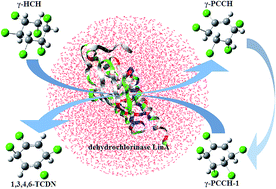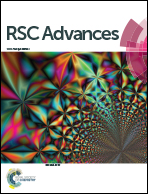Dehydrochlorination mechanism of γ-hexachlorocyclohexane degraded by dehydrochlorinase LinA from Sphingomonas paucimobilis UT26†
Abstract
This study investigated the aerobic degradation mechanism of γ-HCH to 1,3,4,6-TCDN catabolized by dehydrochlorinase LinA from Sphingomonas paucimobilis UT26. The enzymatic step was studied by a combined quantum mechanics/molecular mechanics (QM/MM) computation and the nonenzymatic step was investigated by the DFT method. There are three elementary steps involved in the degradation process. Two discontinuous dehydrochlorination reactions with the Boltzmann-weighted average potential barriers of 16.2 and 17.3 kcal mol−1 are connected by a conformational transition with a barrier of 11.1 kcal mol−1. The electrostatic influence analysis of fourteen key residues surrounding the active site has been carried out. The study reveals that Phe68 facilitates the dehydrochlorination of γ-HCH, whereas Leu21 and Cys71 suppress it. Future mutation studies for improving the degradation efficiency of LinA can focus on mutating the amino acids of Leu21 and Cys71.


 Please wait while we load your content...
Please wait while we load your content...